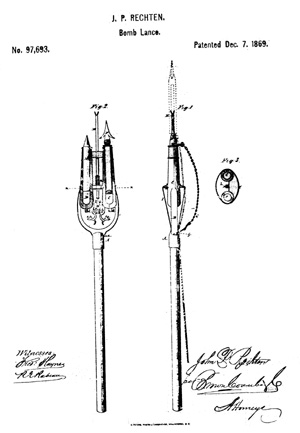 Whalecraft
Whaling
Whalesite
Whalecraft
Whaling
Whalesite

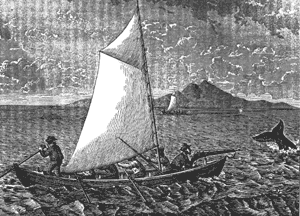
Whaleboat with Greener swivel gun mounted (Scammon, The Marine Mammals of the North-western Coast of North America, 1874) It was not always possible to approach a whale close enough to dart a harpoon into it. This was especially true in the northern fisheries where ice often prevented a close approach. The solution to this problem was thought to be shooting a harpoon from a gun into a whale. The gun, mounted in the bow of the whaleboat, was called a swivel gun because it was secured on a swivel mount to allow turning it for aiming. Such guns were first tried in 1731. Adam Anderson of Dublin, Ireland wrote in Anderson's Historical and Chronological Deduction of the Origin of Commerce, (1790):
At the [South Sea] company's dock there had at this time [1731] been invented a new sort of gun for shooting with gunpowder the harpoons into the bodies of whales, at a greater distance than the harpoons could be thrown by hand; and the ships were accordingly provided with some of them, which were used both in this and the next year's fishery, with some success. They were chiefly adapted to a calm season, and were scarcely practicable in blowing weather, which mostly happens in the Greenland seas. And although the foreign harpooneers could not easily be brought to use them, as being out of their usual method; yet in a ship, fitted out by Mr. Elias Bird and partners, two years after, out of the three whales brought home, two of them were said to be killed by that new-invented gun.
The early swivel guns were flintlocks, and any weather would get the powder in the flash pan wet. As Anderson stated, they were only useful in calm weather.
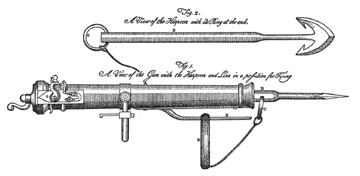
There was no real attention given to swivel guns until the Royal Society of Arts in England, after witnessing experiments with the guns in 1772, offered awards for improvements to the gun and harpoon in an effort to promote the idea. In 1820 William Scoresby wrote:
Between 1772 and 1792, the Society of Arts gave in premiums to whalefishers, and to artisans for improvements in the gun and harpoon, the sum of 350l or 400l In one year only, (1791), they paid 36 guineas as premiums, to twelve persons, who had been successful in the use of the harpoon-gun. Since the year 1792, they have generally been in the habit of offering a premium of 10 guineas, to the harpooner who should shoot the greatest number of whales in one season, not being less than three. This premium, however, though it has been frequently offered, has been seldom claimed. The harpoon-gun has been highly improved, and rendered capable of throwing a harpoon near forty yards with effect; yet, on account of the difficulty and address requisite in the management of it, and the loss of fish, which, in unskillful hands, it has been the means of occasioning, together with some accidents which have resulted from its use, - it has not been so generally adopted as might have been expected.
The illustration above is one of the guns and harpoons, invented by Abraham Staghold, that received premiums from the Royal Society in 1772. It is interesting to note that the design of the swivel-gun harpoon has not changed significantly since then.
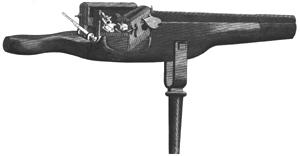
Early improved flintlock swivel gun (Scoresby, An Account of the Arctic Regions, with a History and Description of the Northern Whale-Fishery). George Wallis, Jr., of Hull, England is credited with the first successful swivel gun about 1815. The swivel-mounted harpoon gun of the late eighteenth and early nineteenth centuries was a flintlock with two locks. The flintlock was protected from spray by covering it with a hinged door. The gun had a wrought-iron barrel approximately 24 to 26 inches long, and it had a 1-7/8 inch bore and a 3 inch outside barrel diameter.
The gun described by William Scoresby, and illustrated above, was not used in the American whale fisheries. There was no significant change made to this gun until 1837 when William Greener, a gunsmith in Birmingham, England, made an improved version of it. Greener described the changes he made to the old style swivel guns in his book, The Science of Gunnery, as Applied to the Use and Construction of Fire Arms, London, ca. 1846:
From "Shooting a Harpoon at a Whale," Clark, 1813.
I was then applied to by Captains Warham and Taylor, of the Lord Gambier, and Granville, bay whalers, also of this port, to give the subject some attention. I did so, by lengthening the barrel, adding a little more weight, and reducing the bore to 1-1/2 inch. By a judicious improvement of firing the gun directly behind the bore of the barrel; the addition of a conical form to the breech; and a percussion gun has been fabricated, that I never have yet had a miss-fire with, during one hundred shots. The construction of the lock is very simple, being upon the principle of a saddle pistol lock; caps, the nipples and lock, are completely and effectively covered, and protected from the damp, or spray from the sea. It is also securely bolted until the moment it is wanted; when, by the removal of a pin, the trigger string is pulled, firing the gun, and throwing the harpoon with considerable accuracy, to any distance under eighty-four yards Being the greatest range, by more than double, ever obtained with this description of gun. The charge is very small to project 40 lbs weight, for the harpoon itself is 10-1/2 lbs, and an increasing weight of three-inch line from the gun to the extreme range, in all weighing full 40 lbs.
Greener went on to explain that the use of proper gunpowder was important. Large-grained powder burned more slowly than fine-grained powder and therefore put the harpoon more gradually and evenly in motion.

Greener gun Length is 52-1/2", length of barrel is 36". An advertisement for the improved and successful Greener gun first appeared in the Whalemen's Shipping List, and Merchants' Transcript in New Bedford on February 5, 1850:
Harpoon Gun Greene's [sic] celebrated English harpoon gun, said to be capable of throwing a harpoon forty yards with effect, received for exhibition and sale by Swift & Allen.
This simple advertisement did not stir up too much enthusiasm for the Greener gun, however within two years the success of the Greener gun was well known. An article appeared in the same newspaper on April 13, 1852, which said in part:
We do not remember that we have particularly mentioned the Whaling Gun invented by Mr William Greener, the eminent Gun maker of London. These have been for a long time in use in the British Whaling service, and have been there considered as valuable instruments. We have now the pleasure of adding the testimony of one four own captains in their favor. A letter from Capt Worth of the Ansel Gibbs of Fairhaven states that he had purchased one of Greener's Whaling Guns out of the British whaler Margaret, spoken by him in the China Seas, and bound home with a cargo of sperm oil. Capt Worth had taken one whale with the instrument which he would not otherwise have captured. This whale was struck at a distance of eight fathoms by a harpoon discharged from Greener's Gun. He is strongly of opinion that if he had possessed himself of it earlier he should have been the gainer by two hundred bbls. of sperm oil
For the next few years many advertisements and articles of enthusiastic testimony appeared. The greener gun became a success with little competition, although other swivel guns quickly appeared. Christopher C. Brand and Charles Tracy of Norwich, Connecticut ran an advertisement in the Whalemen's Shipping List, and Merchants' Transcript in New Bedford during most of 1852, stating that:
They also manufacture a Gun for shooting Harpoons, to be mounted on a boat, which is very highly approved. This Gun is about the size of the English Harpoon Guns, and is superior to them in strength, simplicity and convenience in loading and firing.
Although Brand and Tracy's shoulder gun became well known, their swivel gun did not.
The Greener gun found wide use in American whaleships along the California coast where it was especially suited to the calm water that allowed accurate aiming. It was widely used for grey whales. In 1874, Charles M. Scammon said:
were it not for the utility of Greener's gun, the coast fishery would be abandoned, it being now next to impossible to "strike" with the hand-harpoon. At the present time, if the whale can be approached within thirty yards, it is considered to be in reach of the gun-harpoon.
Scammon also explained methods of use and aiming the Greener gun:
The harpoon, four feet and a half long, is projected with considerable accuracy to any distance under eighty-four yards. The gun is mounted on the bow of the boat. A variety of manoeuvres are practiced when using the weapon: at times the boat lying at anchor, and, again, drifting about for a chance shot. When the animal is judged to be ten fathoms off, the gun is pointed eighteen inches below the back; if fifteen fathoms, eight or ten inches below; if eighteen or twenty fathoms distant, the gun is sighted at the top of its back.
According to Greener's son, W. Greener, in his book, "The Gun and Its Development," 1910:
The charge of powder never exceeds six drams, for more doubles up the shank of the harpoon. It is rarely used at greater distances than twenty-five yards, but it is fairly accurate up to forty; and the late W. Greener, whose harpoon guns were by far the best of their day, obtained in a public contest at London Dock, in 1848, an extreme range of 120 yards. Smaller harpoon guns are sometimes made for shooting white-whales, porpoises, walrus, etc, and are carried by yachts on Arctic trips.
The Greener gun fired a large harpoon weighing approximately ten pounds over a distance of thirty to forty yards. The gun was made with three different bores - 1-1/4", 1-1/2" and 1-7/8" The gun was mounted in the bow of a whaleboat and was discharged by pulling a lanyard fastened to a
trigger in the gun. The Greener guns were made with a percussion hammer that struck two nipples, both of which fired the gun. This was to reduce the possibility of a misfire. The barrel was mounted in a wood stock with a small hand grip at the rear to swivel the gun for aiming. A brass hinged cover enclosed the hammers and nipples to protect them against sea water. A brass ramp sight ran along the top of the barrel. The complete gun, less the harpoon, weighed about seventy-five lbs.
Greener gun - hammer struck two percussion caps on nipples simultaneously.

Greener gun irons top: toggle head, length 48"; bottom: two flue, length 48-1/2" Both are for 1-1/4" bore. The harpoons used in Greener guns changed very little over the years, but the head changed as the hand-darted irons changed. Greener irons are found with two flue, single flue, pivot barb and toggle heads. The whaleline was attached to a ring that could slide the length of a slot in the shank. When loaded in the gun, the ring was forward toward the head, outside the barrel. When the iron was discharged, the ring wound up at the butt end with the whaleline trailing behind.
One area of change was in the shank of the Greener irons. They were mostly made with the slot as pictured above, but there were some with a solid shank similar to the hand darted irons. Scoresby described the solid shank in 1820:
Some harpoons have been lately made with a single shank, similar to the common "hand-harpoon," but swelled at the end to the thickness of the bore of the gun. The whale line, which is closely spliced round the shank, is slipped towards the mouth of the harpoon, when it is placed in the gun, and when fired, is prevented from disengaging itself, by the size of the knob at the end.
The slotted, or "double shank" Greener irons were much more favored, however. There were many letters of testimony that appeared in The Whalemen's Shipping List, and Merchants' Transcript in New Bedford during 1852. The following is a sampling of those letters:
[From Captain George Harrison, of the Lady Jane of Newcastle, 1848] I can confidently recommend them, the double shanked harpoon never failed, the single shanked I have seen fail twice out of thrice. I got two single shanked gun harpoons from Aberdeen upon trial, which proved a complete failure. I would not allow one to be put into my boats. When fired they went side first and aften [sic] butt end first.
[From Capt John Gray of the 'Eclipse' of Peterhead] We do not use the single shank Harpoon at all from this port. The 'Commerce,' last year lost several fish with them from the heads coming off - the double shank is much preferred.
[From captain William Penney of the 'Advice' of Dundee, now in command of Lady Franklin's expedition from Peterhead] Murray's Harpoon is a complete failure, nothing will do but your double shank.
William Greener's gun became very successful and was used in American whale fisheries as well as British. The harpoons were commonly called Greener irons, no matter what blacksmith made them, what head configuration they had, or whether they were British or American.
There was some further development made to improve the Greener gun, however. One problem was the recoil force from firing such a large harpoon. This force was transmitted directly to the whaleboat in which the gun was mounted. Whaleboats were of a light weight construction, and not intended to endure repeated shocks of such recoil forces. And there were other changes made in an effort to improve this gun.
An early improvement to the Greener gun was made in Germany. John Phillip Rechten from Bremen, Germany, worked with a gun maker, H. G. Cordes from Bremerhaven, Germany around 1856. (Rechten received a German patent for a bomb lance in 1856.) Rechten and Cordes improvements to the Greener gun included; the bore was 50 mm (197 in - larger than the Greener gun), the length of the gun was 127 cm (50 in), and the length of the harpoon was 107 cm (42-1/8 in).
Early single-barrel Cordes and Rechten swivel gun. Information and photo from Lars Bottcher, Germany. The gun is in the Altonaer Museum, Hamburg.
The second version of the Cordes and Rechten swivel gun had two barrels, side by side. The left barrel was smooth bore for a harpoon. The right barrel for the
bomb lance was rifled with three grooves, and gave a twist of one turn in 40 feet This gun was used successfully in the North Sea around 1867. Pulling two lanyards, or cords, attached to the triggers discharged both barrels of the gun at the same time. The barrels were 24"long, and the gun weighed 160 lbs. There were two versions of the harpoon: one was made of iron and had a wood shaft, the second was all iron, as shown in the illustration at the right. The two-flue head of the harpoon was 5" long. The bomb lance was made of iron, 15" long with a 5" long point. The explosive cylinder was 8" long and had a diameter of 2-1/8". A fuse at the base of the bomb was ignited by the flash of the gunpowder, and burned for 25 seconds, and would burn under water. The bombshell contained 1-3/4 lbs of gunpowder At the base of the bomb lance was a brass screw with a head 2" long, and three setting lugs to match the three grooves in the rifled barrel.
(This information and the accompanying illustration (above, right) of the Cordes and Rechten gun are provided by Lars Bottcher of Germany, and come from an old newspaper article in the August 6, 1867, issue of "ILLUSTRIERTE ZEITUNG").
The Überseemuseum in Bremen, Germany, has a Cordes double-barrel harpoon cannon of 1867, of the type Svend Foyn experimented with for one season; possibly the item lost from the Focke Museum collection during WW II ( See Links page This information from Klaus Barthelmess, Cologne, Germany).
Note the similarity of the Cordes and Rechten swivel gun with two barrels and the darting gun patented by John P. Rechten in the United States in 1869, two years later (U.S. Patent No. 97,693, Dec 7, 1869). This darting gun also had two side by side barrels, and fired a harpoon and bomb lance simultaneously.
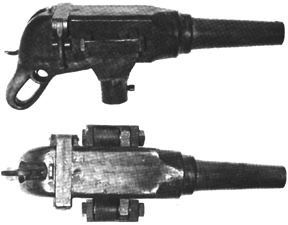
Mason and Cunningham swivel gun. Length is 28-1/2", length of barrel is 21-3/8", bore is 1-1/2". Henry W. Mason and Patrick Cunningham of New Bedford were jointly granted a U.S. Patent in 1882 for their whaling-gun invention that focused on a method of mounting a swivel gun in a manner to reduce the recoil forces transmitted to the whaleboat (U.S. Patent No. 269,080, Dec 12, 1882). Mason and Cunningham mounted their swivel gun on heavy rubber cushions. The
shock absorbing rubber cylinders were positioned on both sides of the trunnion mounting, and around the mounting post where it passed through the thighboard of the whaleboat (a heavy structural member in the bow). These shock absorbing cushions were the patented feature. The gun was mounted to the trunnion rods parallel to the gun barrel so it could slide back and forth on them. The rubber cylinders were placed around the two rods behind the lugs on the gun through which the rods passed. When the gun was fired, recoil forced it back compressing the rubber cushions. This reduced the forces transmitted to the whaleboat
Patent drawing for Mason and Cunningham swivel gun.
The Mason and Cunningham swivel gun was loaded by opening a breechblock and inserting a cartridge - gunpowder was not muzzle loaded, and the gun did not use percussion caps on nipples. After the cartridge was loaded and the breechblock locked closed, the harpoon was loaded into the muzzle of the gun The gun was cocked by pulling back an exposed hammer. The gun was fired with a finger trigger, unlike the Greener guns that were fired by pulling a lanyard attached to a trigger. Because it was intended primarily for use in the Arctic, the gun was made of gun metal (a bronze alloy) rather than iron which would be too brittle at very cold Arctic temperatures.
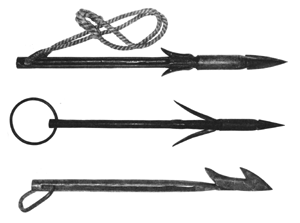
Mason and Cunningham harpoons. Top: typical type. Length is 33-3/4" Center: early type with double shank. Length is 38-13/16". bottom: non-explosive toggle iron for Mason and Cunningham gun, slotted shank. Length is 29". The barrel of the Mason and Cunningham gun was shorter than that of a Greener gun, and so a different harpoon was used. The harpoon was not patented, but was described in the gun patent. It was a bomb harpoon that would explode in the whale to kill it, eliminating hand lancing which was difficult in the Arctic. A cylindrical bomb shell screwed onto the main harpoon casting A sharp penetrating point with four longitudinal cutting edges screwed into the front of the bomb shell. Immediately behind the bomb were two large pivot barbs mounted in a slot in the harpoon casting; the barbs pivoted on a single common pivot pin. An early version of the harpoon was made with the slotted shank feature, with a ring for attaching the whaleline, similar to the Greener irons. A later version was made with a solid shank, with four longitudinal grooves in which the whaleline would lie when placed in the gun barrel in this version, a three-foot length of whaleline was rove through a hole near the butt end of the harpoon and was spliced to form a continuous loop. The loop of whaleline passed forward in two of the grooves in the shank and the end of the loop was outside the muzzle of the gun barrel where it was then attached to the main warp
In addition to the bomb harpoon, a non-explosive toggle-head harpoon was made for the Mason and Cunningham gun. This was the same as the Greener irons, with the slotted shank, but the shank was much shorter to fit the Mason and Cunningham gun. All three were made specifically for the Mason and Cunningham gun, and fit the 1-1/2" bore.
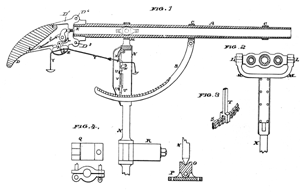
John J. Haviside swivel gun - patent drawing. Another swivel gun was patented by John J. Haviside of San Francisco in 1885 (U.S. Patent No. 324,935, Aug 25, 1885). The object of the invention, as expressed by Haviside, was:
My invention relates to a whaling-gun and stand by which it may be supported within the boat, so as to resist the recoil or kick of the gun when fired.
His patent claims (there are seven claims) also include a gun with two or more barrels and a corresponding number of hammers operating on a single shaft to discharge all barrels simultaneously.
This gun had three barrels; the center barrel discharged a gun harpoon while the two outer barrels discharged bomb lances. All three barrels were fired simultaneously by three hammers and three firing pins The entire rear section of the gun, containing the firing mechanism, swung up to expose the ends of the barrels so cartridges could be loaded into each barrel. When closed, this rear section was secured by a large locking pin. Haviside hinted at the gun being used in the Arctic when he described the enclosed firing mechanism:
By this construction the interior of the lock-case is kept perfectly tight and free from water and ice.
The three barrels were held together by permanent clamps around them. A large curved rack was secured to the gun barrels by means of one of the barrel clamps. The rack curved downward and to the rear through a slot in a mounting post. The rack moved easily through this slot as the gun barrels were raised and lowered for aimimg. Ratchet teeth on the rack were provided to secure the rack in position for firing. The lower end of the gun support standard fit into a hinged step in the bottom of the whaleboat.
No example of the Haviside gun could be found. There was no mention of any special harpoon or bomb lance in the patent, so it is presumed that any existing harpoon and bomb lance that fit the barrels properly would be used. Such a bomb lance is described below, and would indicate that the bore of the Haviside gun may have been 1-1/4", at least for the bombs.
Christopher C Brand #4 bomb lance for swivel guns (rubber fins missing). Length is 34-1/2", diameter is 1-1/4".
(Author's collection)
There was one bomb lance specifically made for the large swivel guns. It was designed and manufactured by Christopher C. Brand of Ledyard, Connecticut in 1852. It could have been used in any of the guns above that had a 1-1/4" bore. This bomb lance was patented by Brand in 1852 (U.S. Patent No. 9,047, June 22, 1852). The patent was for folding rubber fins that kept the bomb on its trajectory during flight. Brand claimed:
my improved mode of making them, viz, of vulcanized india-rubber or other equivalent, so that they may not only resist the destructive powers of the explosion, but be folded down on the shank when put into a gun-barrel, and have the property of elasticity, such as will enable them to unfold themselves after being discharged from the gun.
Patent drawing for Christopher C. Brand bomb lance.
The patent did not specifically identify swivel guns, but C.C. Brand made four sizes of this design, the size for swivel guns being #4. The differences were in length and diameter. There does not appear to be any other bomb lance specifically made for swivel guns.
Back to top of this page


